hnRNP G/RBMX enhances HPV16 E2 mRNA splicing through a novel splicing enhancer and inhibits production of spliced E7 oncogene mRNAs
- PMID: 35357488
- PMCID: PMC9023273
- DOI: 10.1093/nar/gkac213
hnRNP G/RBMX enhances HPV16 E2 mRNA splicing through a novel splicing enhancer and inhibits production of spliced E7 oncogene mRNAs
Abstract
Human papillomavirus type 16 (HPV16) E2 is an essential HPV16 protein. We have investigated how HPV16 E2 expression is regulated and have identifed a splicing enhancer that is required for production of HPV16 E2 mRNAs. This uridine-less splicing enhancer sequence (ACGAGGACGAGGACAAGGA) contains 84% adenosine and guanosine and 16% cytosine and consists of three 'AC(A/G)AGG'-repeats. Mutational inactivation of the splicing enhancer reduced splicing to E2-mRNA specific splice site SA2709 and resulted in increased levels of unspliced E1-encoding mRNAs. The splicing enhancer sequence interacted with cellular RNA binding protein hnRNP G that promoted splicing to SA2709 and enhanced E2 mRNA production. The splicing-enhancing function of hnRNP G mapped to amino acids 236-286 of hnRNP G that were also shown to interact with splicing factor U2AF65. The interactions between hnRNP G and HPV16 E2 mRNAs and U2AF65 increased in response to keratinocyte differentiation as well as by the induction of the DNA damage response (DDR). The DDR reduced sumoylation of hnRNP G and pharmacological inhibition of sumoylation enhanced HPV16 E2 mRNA splicing and interactions between hnRNP G and E2 mRNAs and U2AF65. Intriguingly, hnRNP G also promoted intron retention of the HPV16 E6 coding region thereby inhibiting production of spliced E7 oncogene mRNAs.
© The Author(s) 2022. Published by Oxford University Press on behalf of Nucleic Acids Research.
Figures


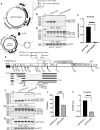

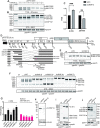

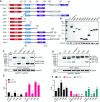
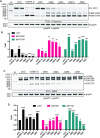
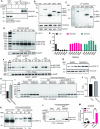

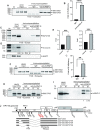

Similar articles
-
A novel HPV16 splicing enhancer critical for viral oncogene expression and cell immortalization.Nucleic Acids Res. 2024 Jan 11;52(1):316-336. doi: 10.1093/nar/gkad1099. Nucleic Acids Res. 2024. PMID: 37994701 Free PMC article.
-
Heterogeneous Nuclear Ribonucleoprotein A1 (hnRNP A1) and hnRNP A2 Inhibit Splicing to Human Papillomavirus 16 Splice Site SA409 through a UAG-Containing Sequence in the E7 Coding Region.J Virol. 2020 Sep 29;94(20):e01509-20. doi: 10.1128/JVI.01509-20. Print 2020 Sep 29. J Virol. 2020. PMID: 32759322 Free PMC article.
-
hnRNP H controls alternative splicing of human papillomavirus type 16 E1, E6, E7, and E6^E7 mRNAs via GGG motifs.J Virol. 2024 Oct 22;98(10):e0095124. doi: 10.1128/jvi.00951-24. Epub 2024 Sep 17. J Virol. 2024. PMID: 39287390 Free PMC article.
-
Splicing and Polyadenylation of Human Papillomavirus Type 16 mRNAs.Int J Mol Sci. 2017 Feb 9;18(2):366. doi: 10.3390/ijms18020366. Int J Mol Sci. 2017. PMID: 28208770 Free PMC article. Review.
-
Control of human papillomavirus gene expression by alternative splicing.Virus Res. 2017 Mar 2;231:83-95. doi: 10.1016/j.virusres.2016.11.016. Epub 2016 Nov 17. Virus Res. 2017. PMID: 27867028 Free PMC article. Review.
Cited by
-
A candidate protective factor in amyotrophic lateral sclerosis: heterogenous nuclear ribonucleoprotein G.Neural Regen Res. 2023 Jul;18(7):1527-1534. doi: 10.4103/1673-5374.357916. Neural Regen Res. 2023. PMID: 36571358 Free PMC article.
-
Differences in splicing factors may predict type 2 diabetes remission in the CORDIOPREV study.iScience. 2024 Dec 4;28(1):111527. doi: 10.1016/j.isci.2024.111527. eCollection 2025 Jan 17. iScience. 2024. PMID: 39811651 Free PMC article.
-
HPV and RNA Binding Proteins: What We Know and What Remains to Be Discovered.Viruses. 2024 May 15;16(5):783. doi: 10.3390/v16050783. Viruses. 2024. PMID: 38793664 Free PMC article. Review.
-
A novel HPV16 splicing enhancer critical for viral oncogene expression and cell immortalization.Nucleic Acids Res. 2024 Jan 11;52(1):316-336. doi: 10.1093/nar/gkad1099. Nucleic Acids Res. 2024. PMID: 37994701 Free PMC article.
-
High-Risk Human Papillomavirus Oncogenic E6/E7 mRNAs Splicing Regulation.Front Cell Infect Microbiol. 2022 Jun 27;12:929666. doi: 10.3389/fcimb.2022.929666. eCollection 2022. Front Cell Infect Microbiol. 2022. PMID: 35832386 Free PMC article. Review.
References
-
- Walboomers J.M., Jacobs M.V., Manos M.M., Bosch F.X., Kummer J.A., Shah K.V., Snijders P.J., Peto J., Meijer C.J., Munoz N.. Human papillomavirus is a necessary cause of invasive cervical cancer worldwide. J. Pathol. 1999; 189:12–19. - PubMed
-
- Chow L.T., Broker T.R., Steinberg B.M.. The natural history of human papillomavirus infections of the mucosal epithelia. APMIS. 2010; 118:422–449. - PubMed
-
- Schiffman M., Doorbar J., Wentzensen N., de Sanjose S., Fakhry C., Monk B.J., Stanley M.A., Franceschi S.. Carcinogenic human papillomavirus infection. Nat. Rev. Dis. Primers. 2016; 2:16086. - PubMed
MeSH terms
Substances
LinkOut - more resources
Full Text Sources

